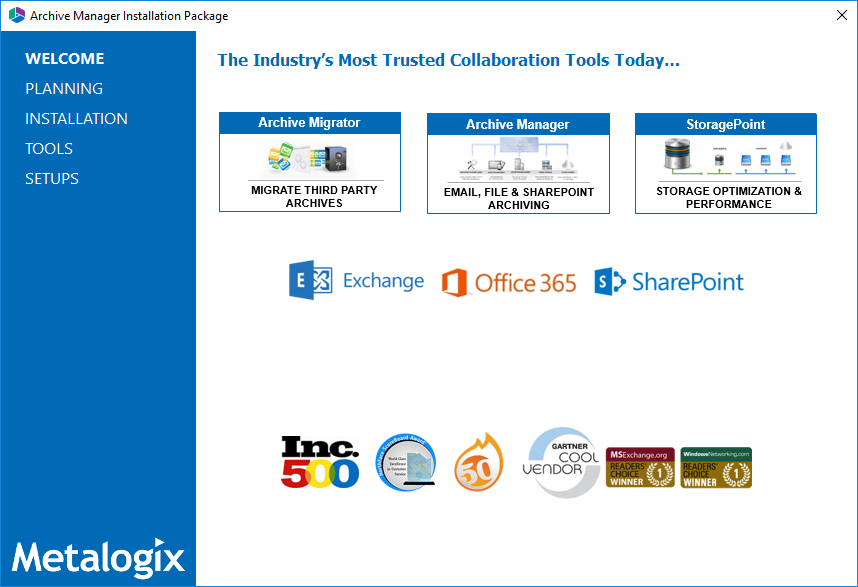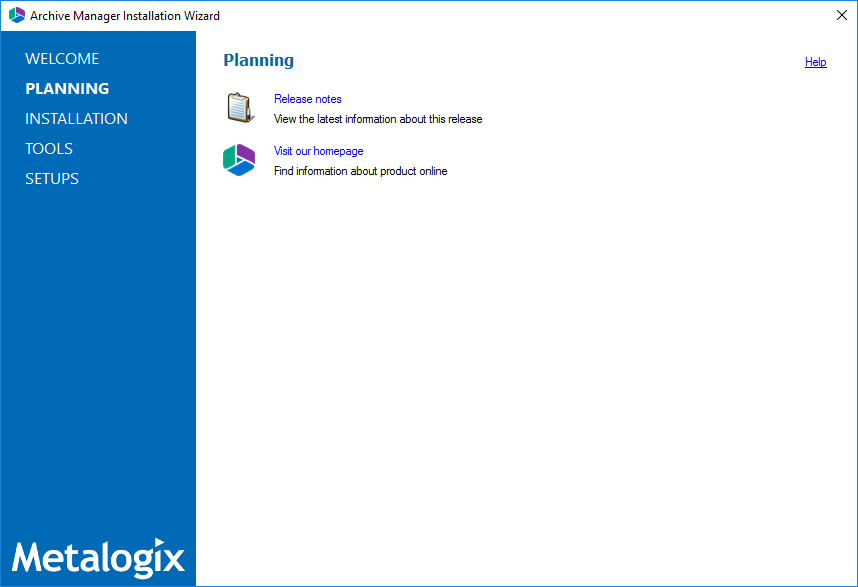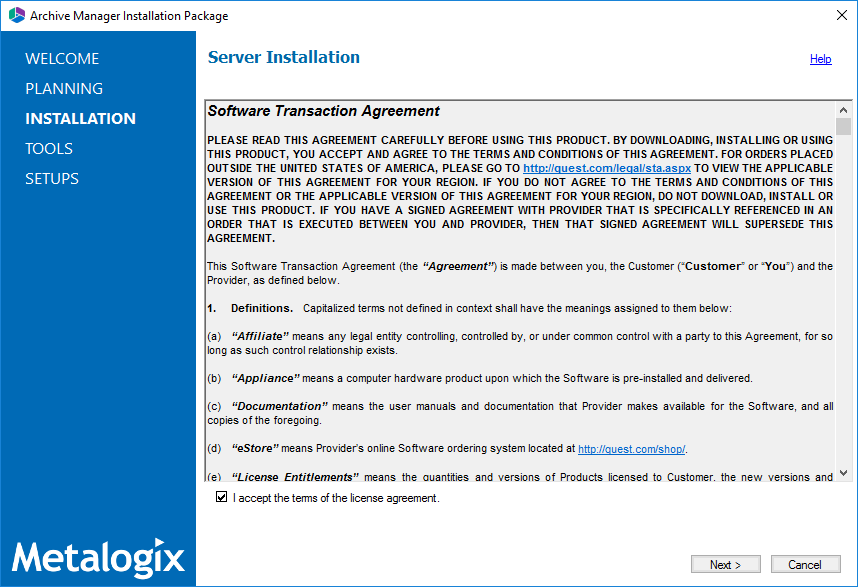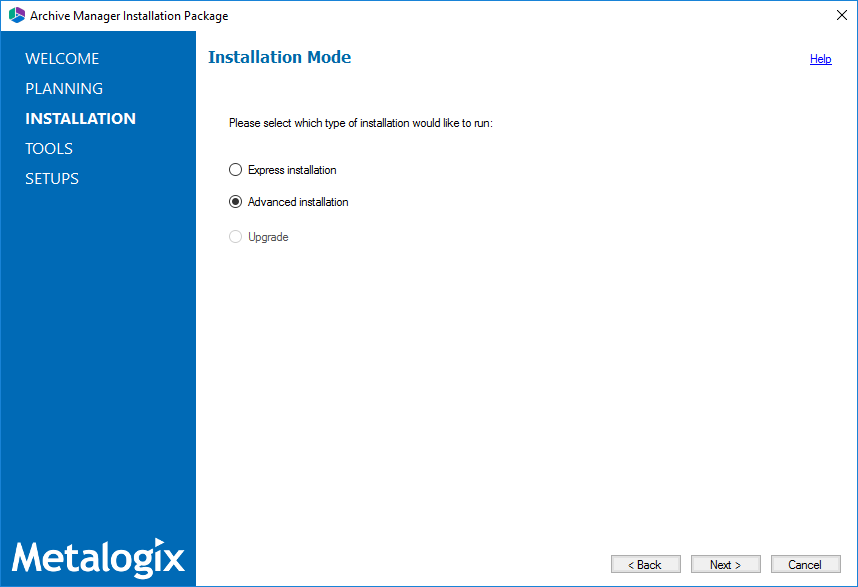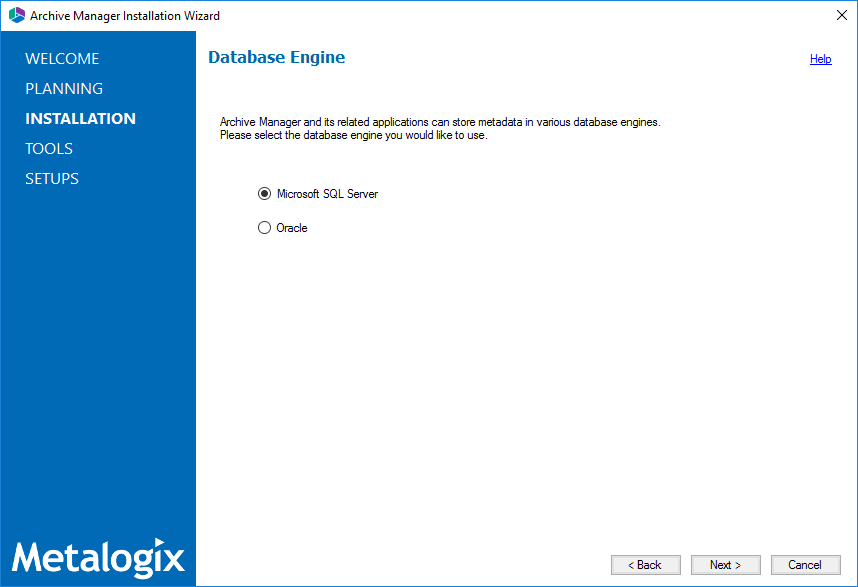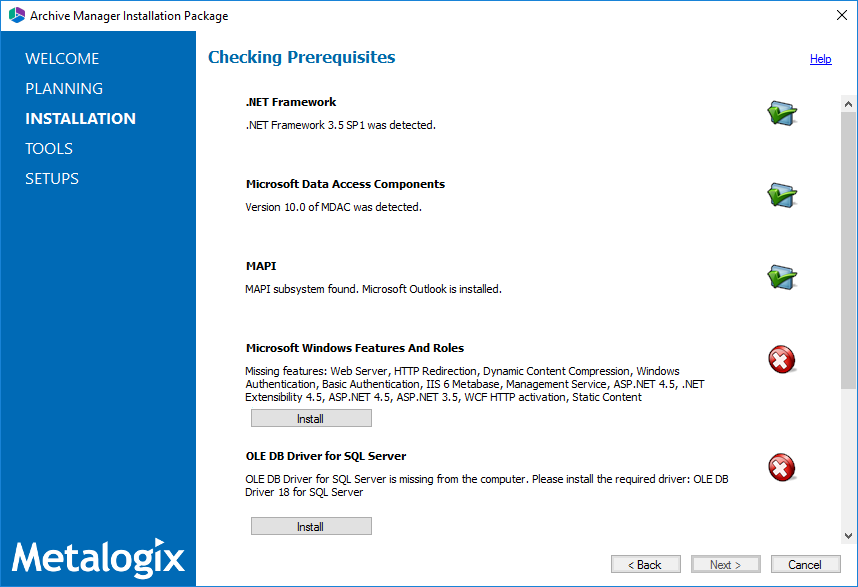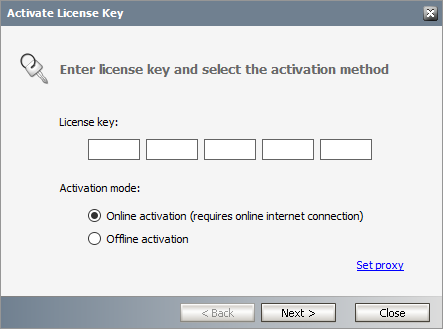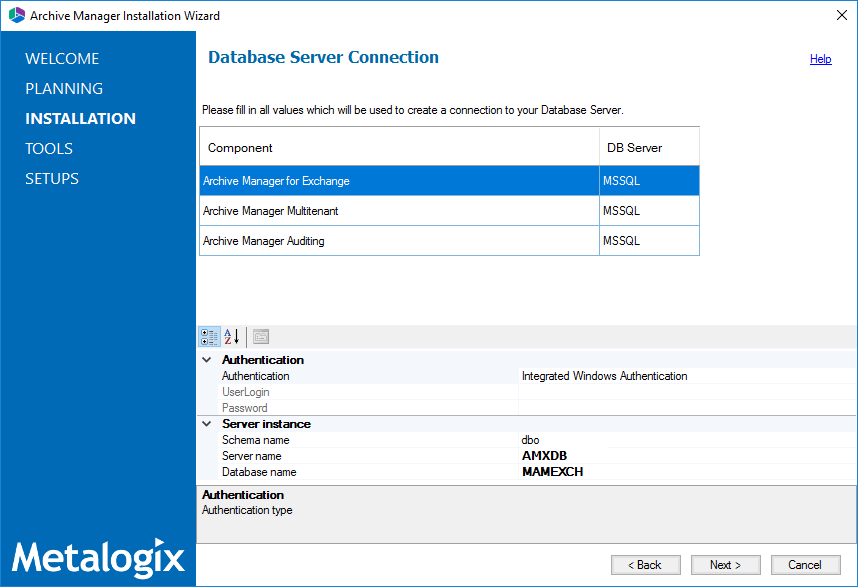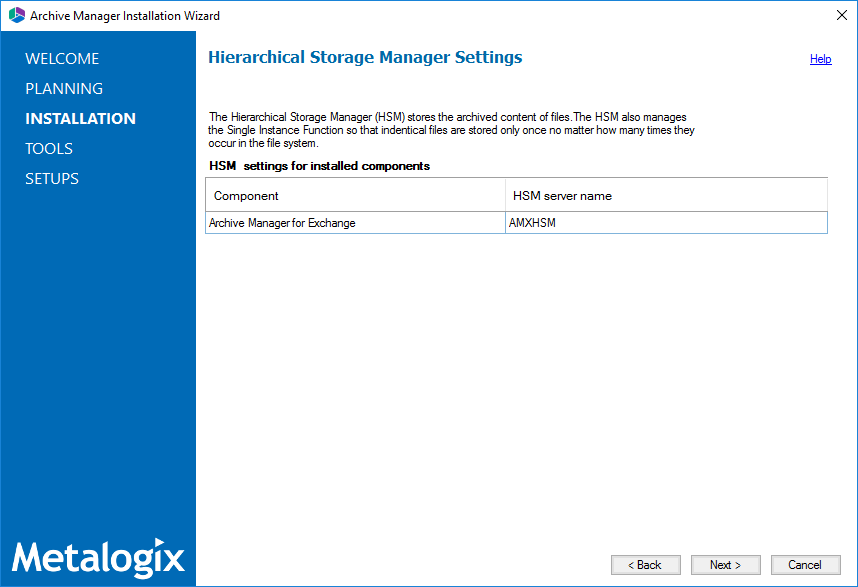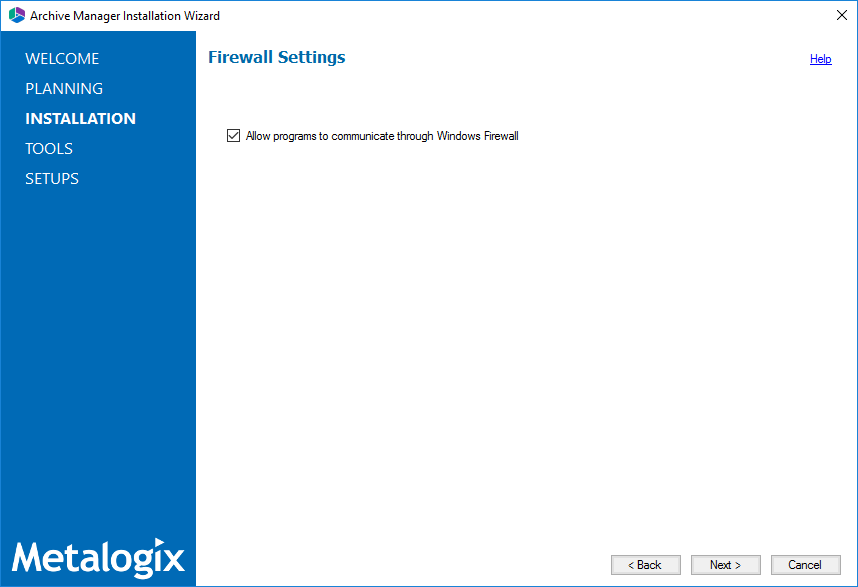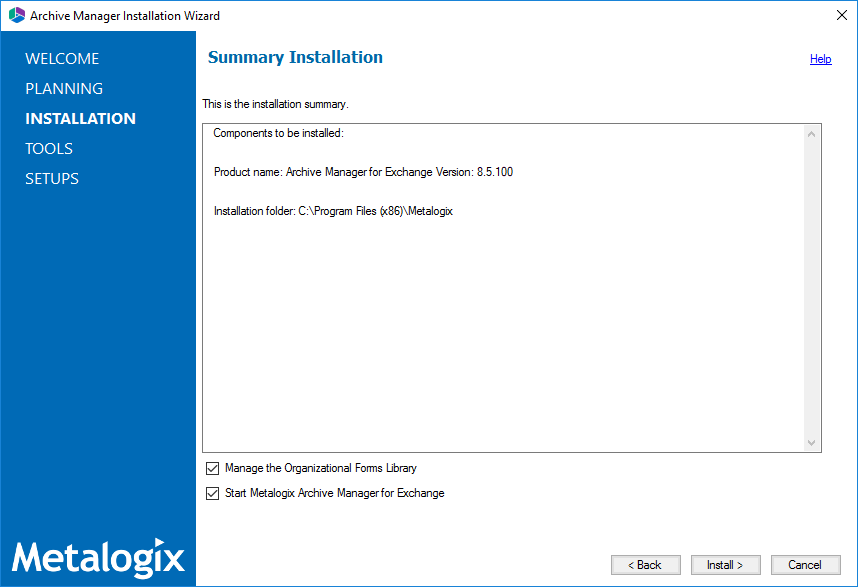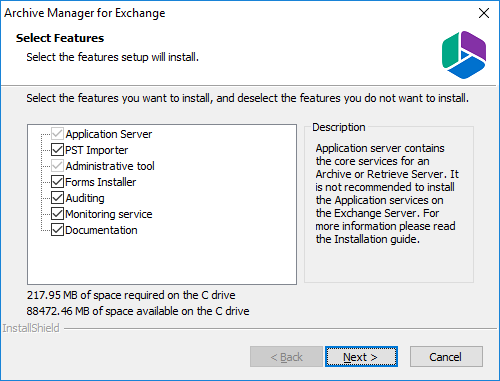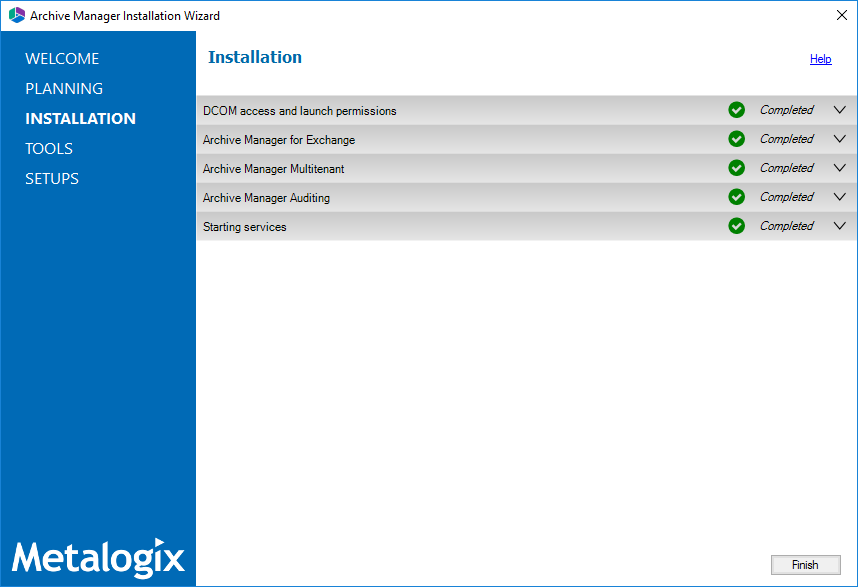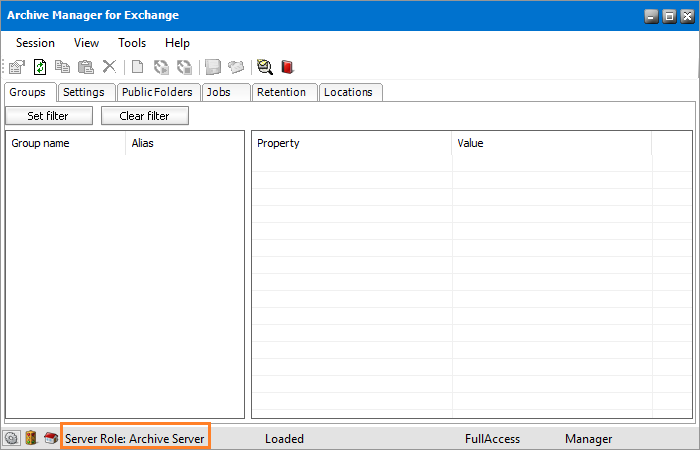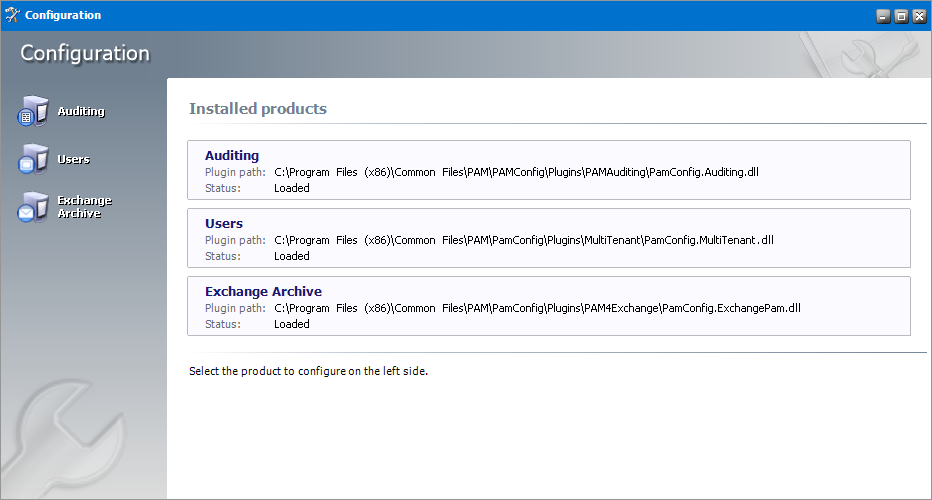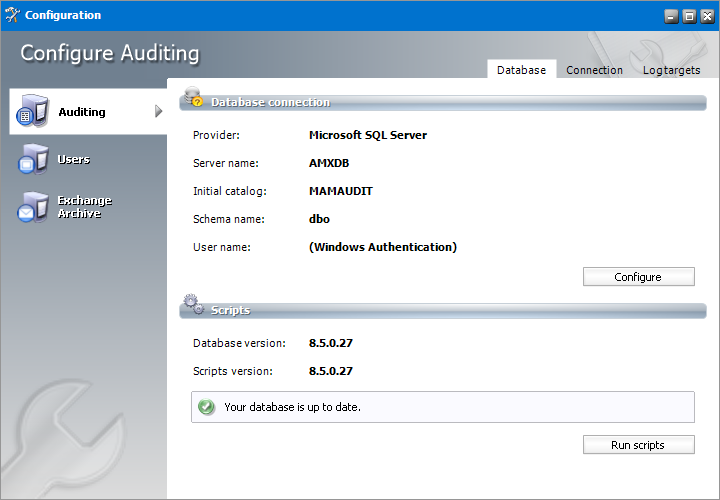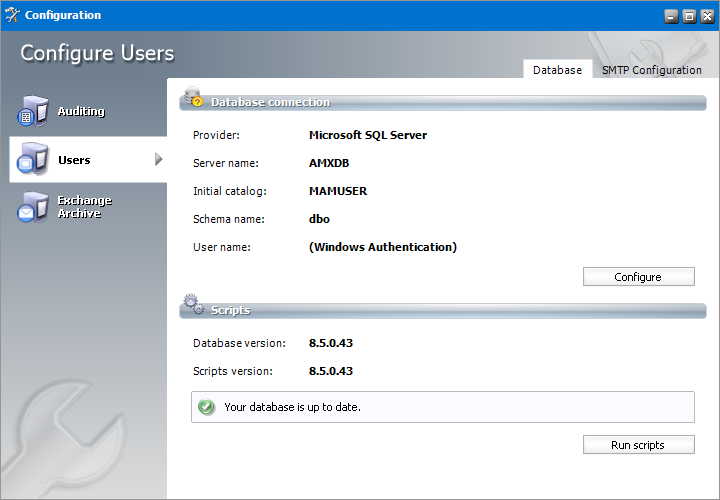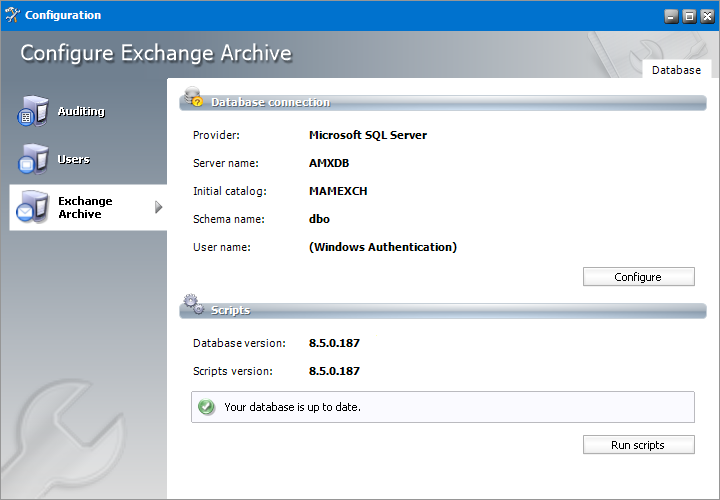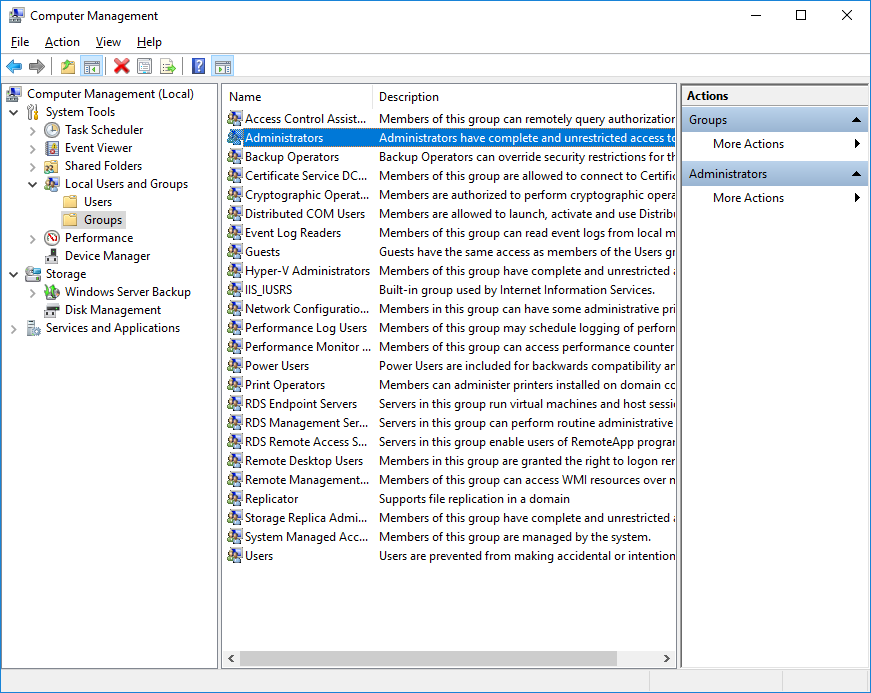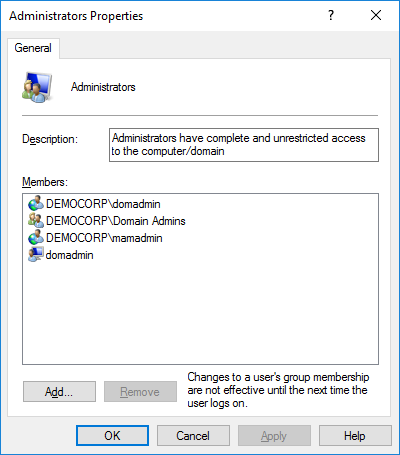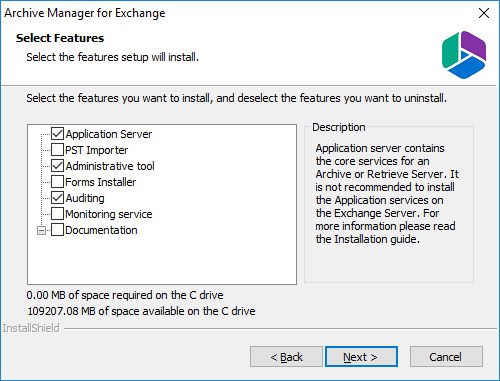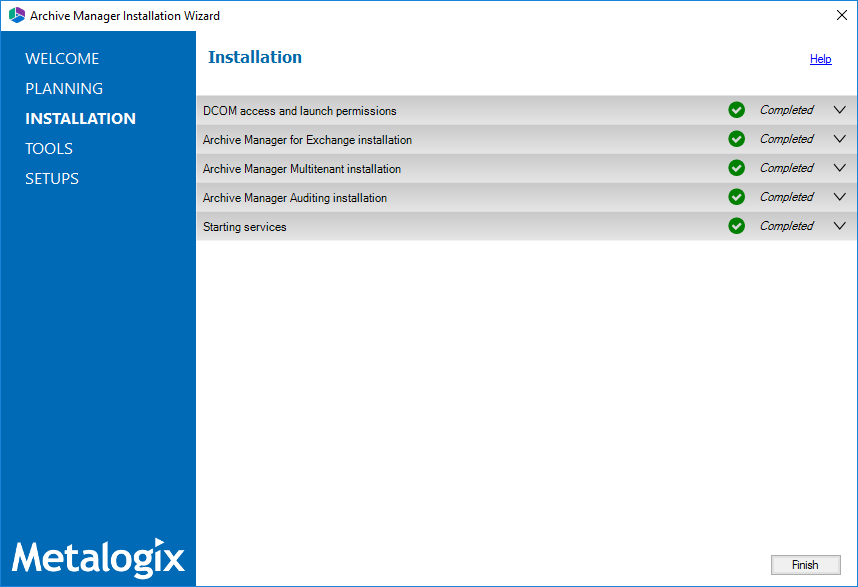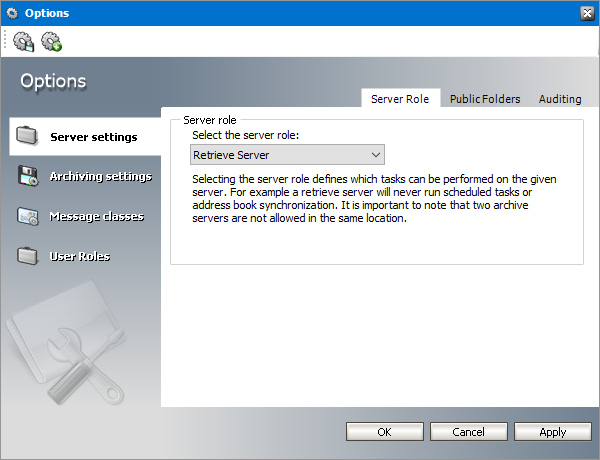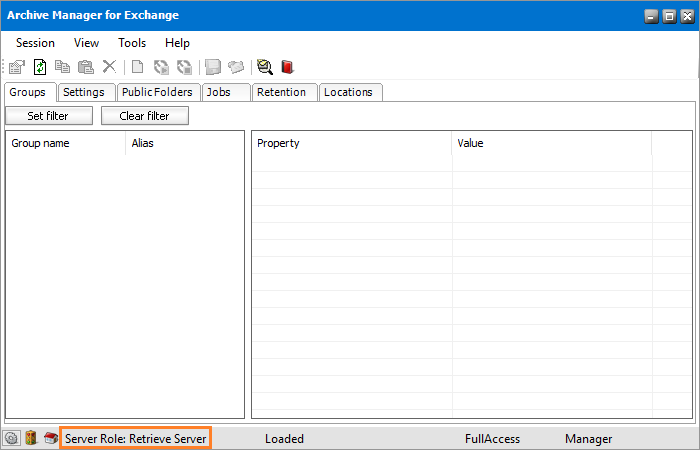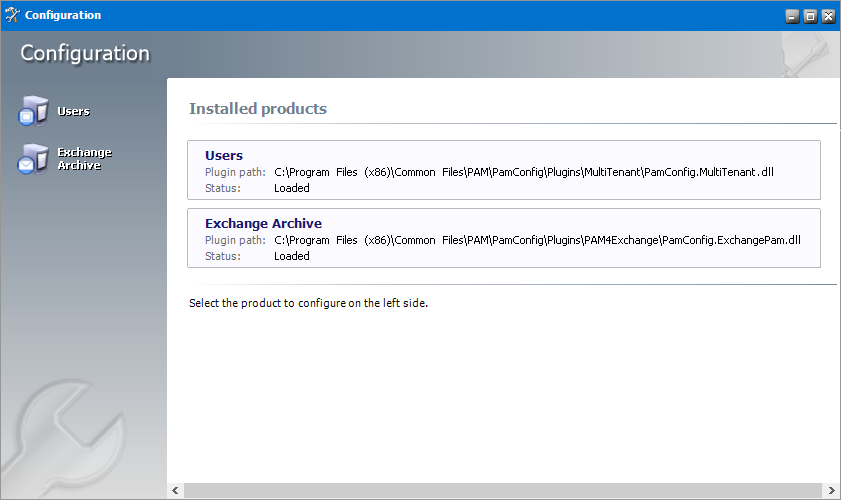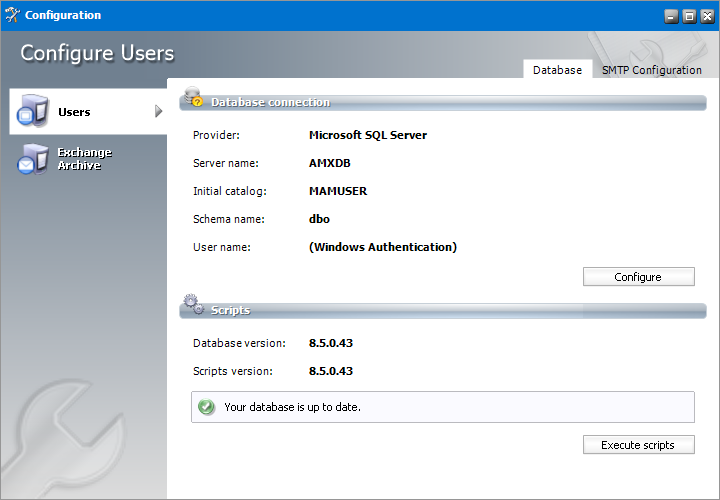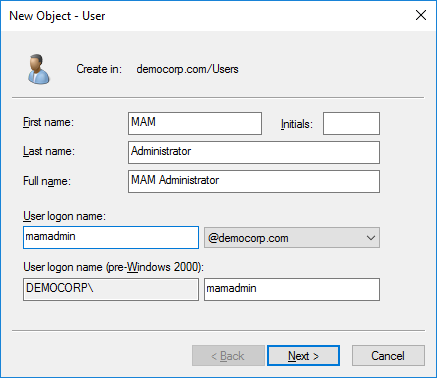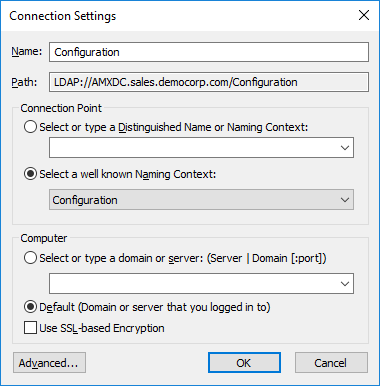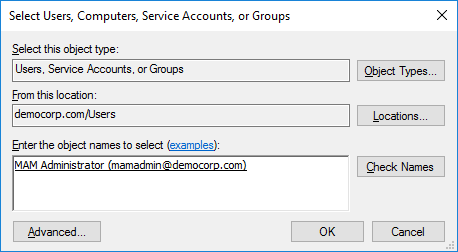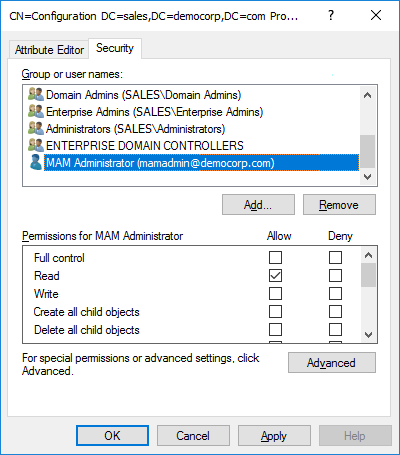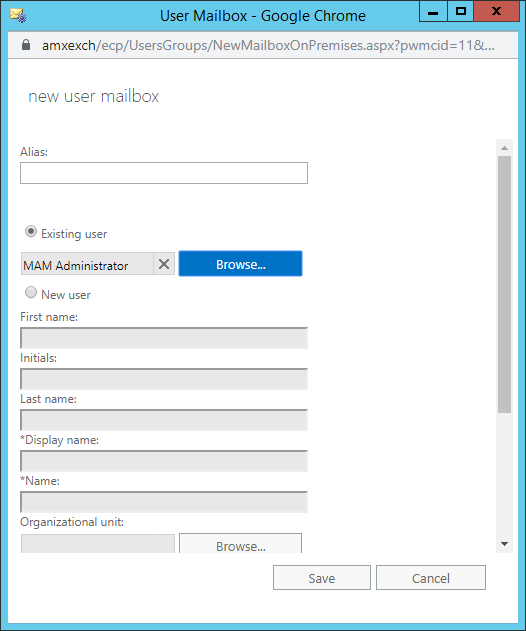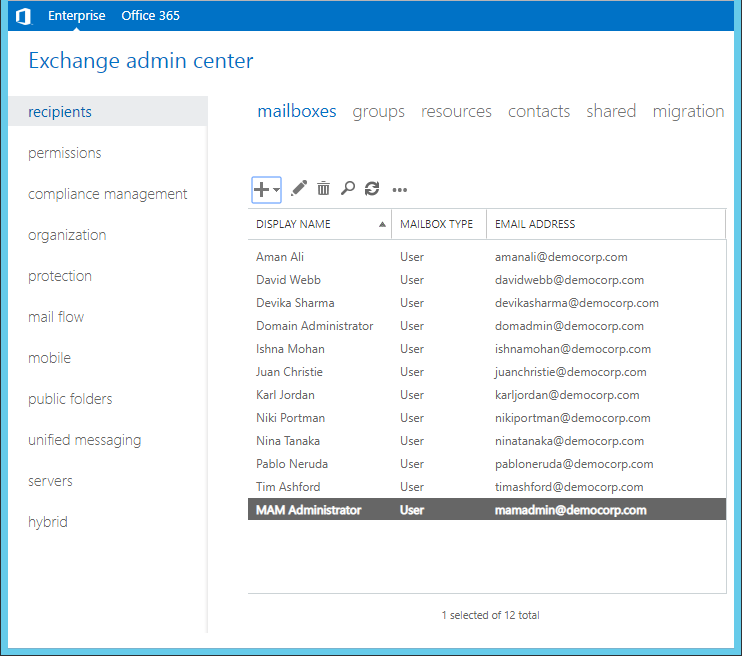Install the Archive server
In this topic:
·Worksheet for this installation
·Steps to install Metalogix Archive Manager for Exchange
·Steps to configure and verify the Archive server
Worksheet for this installation
The following information will be required through the installation process. Sample values are provided here as a guidance.
|
Item |
Description |
Example |
|
License Key |
The license key that you received from Quest. If you don't have a license key, contact your Quest representative. |
894K5-3M448-M544E-A594A-7K8Z7 (Sample only. This key is neither an active nor an expired license key) |
|
Archive Manager for Exchange server |
The server where the Archive Manager for Exchange will be installed. |
AMXSERVER-A |
|
Installer account |
Windows account that is used to install the application. This is usually the enterprise administrator. |
username: democorp\domadmin password: ************** |
|
Superuser account |
Windows account that is used to run the application and run the Archive Manager for Exchange services. |
username: democorp\mamadmin password: ************** |
|
Media Folder |
Full path of the folder where the media files are extracted |
C:\Metalogix |
|
Installation folder |
Full path of the folder where the application files will be installed |
C:\Program Files (x86)\Metalogix |
|
Database Authentication method |
Type of database authentication: Integrated Windows Authentication or SQL Authentication |
Integrated Windows Authentication |
|
UserLogin |
Username if SQL Authentication is selected |
dbadmin |
|
Password |
Database password if SQL Authentication is selected |
************** |
|
Database server |
The database server instance name where the databases for Archive Manager for Exchange will be installed. |
AMXDB |
|
HSM server |
The server where HSM is installed. |
AMXHSM |
|
Search server |
The server where the Archive Manager Search is installed. |
AMXHSM |
Steps to install Metalogix Archive Manager for Exchange
1.Log in to the server with the credentials of the enterprise administrator (eg. democorp\domadmin).
2.Run the Metalogix Archive Manager Installation Package to extract the files to a local folder.
3.If the installer does not start immediately, run the MAMInstaller.exe from your install media folder. The Welcome window opens.
4.From the navigation panel on the left, click PLANNING. The Planning window opens.
Review the requirements and release notes. If necessary, visit the Quest website for more information.
5.From the navigation panel on the left, click INSTALLATION. The Server Installation window opens.
Read the Software Transaction Agreement. If you wish to proceed, select the I accept the terms of the license agreement check box.
6.Click Next. The Installation Mode window opens. Select the Advanced installation option
7. Click Next. The Installation Components window opens.
Select Archive Manager for Exchange.
|
|
NOTE: Archive Manager for Files could be installed on the same server. Installation of Archive Manager for Files is described in the Metalogix® Archive Manager for Files Advanced Installation Guide. ArchiveWeb is an enhancement. Installation of ArchiveWeb is described in the Metalogix® Archive Manager for Exchange ArchiveWeb Guide. |
8.Click Next. The Database Engine selection window opens.
Select either Microsoft SQL Server (for on-premise MS SQL Database Server or Azure SQL Database) or Oracle.
9.Click Next. The Checking Prerequisites window opens.
If one or more prerequisites are missing, the Next button will appear deactivated. Click Install for each prerequisite to install the missing features. Scroll down to expose and install all the prerequisites.
Scroll down to the bottom of the window. Click Validate your license. The Activate License Key dialog opens.
If you are connected to the internet, select Online activation or see License Activation for more options. Click Next. When your license is activated, you will see a confirmation message and the license details. Click Finish to close the Activate License Key dialog.
10. In the Checking Prerequisites window, click Next. The Superuser Account window opens.
Specify the Superuser name and Password. Enter the password again in the Retype password field.
11.Click Next. The Database Server Connection window opens.
|
|
NOTE: If you selected Oracle as your database engine, then the the Database Server Connection window for Oracle opens. |
Enter the database parameter values described below:
For Microsoft SQL Server
a.Authentication - database authentication method.
b.UserLogin - Username if SQL Authentication or Oracle client is selected. Otherwise this field is deactivated.
c.Password - Database password if SQL Authentication or Oracle client is selected. Otherwise this field is deactivated.
d.Schema name - Username of the installer account without the domain prefix. For example dbo.
e.Server name - The name of the server where you are installing the HSM and Archive Manager Search.
f.Database name - The name of the database that will contain the HSM metadata. The default name is MAMHSM.
For Oracle
a.Oracle net name - net service name that describes the network address of the database server in your tnsnames.ora file.
b.Schema - name of the Oracle schema from your tnsnames.ora file.
c.User name - database login user name.
d.Password - password of the database user.
12.Click Next. The Hierarchical Storage Manager Settings window opens.
In the HSM server name field enter the name of the server where the HSM application feature is installed. For example AMXHSM.
13.Click Next. The Please select the type of installation window opens.
In the Search server field enter the name of the server where the Archive Manager Search feature is installed. For example AMXHSM.
14.Click Next. The Firewall Settings window opens.
Select the Allow programs to communicate through Windows Firewall check box. Metalogix Archive Manager for Exchange features will be then able to communicate through the firewall.
15.Click Next. The Summary Installation window opens. The installation summary displays settings you have specified in previous steps.
a.Select Manage the Organizational Forms Library if your organization uses this public folder to share email templates. Otherwise, clear the check box.
b.Select the check box Start Metalogix Archive Manager for Exchange to open the Archive Manager for Exchange Administration Center (AMAC) when the installation completes.
16.Click Install to start the installation.
17.When the installer starts installing the Archive Manager for Exchange feature, the Select Features window of the Archive Manager for Exchange opens.
Mandatory features
·Application Server
·Administrative tool
Optional features
·Auditing
·Monitoring service
Optional resources
·PST Importer
·Forms Installer
·Documentation
Keep the default selections to experience the full range of features. Then click Next to install the features.
18.Click Next to continue the installation. If a feature installation fails or completes with a warning, expand the row to view and address the problem.
19.Click Finish to complete the installation step.
20.The Archive Manager for Exchange Administration Center (AMAC) should open automatically if the check box Start Metalogix Archive Manager for Exchange was checked in the Summary Installation step of the installation wizard.
21.The Address Book Setup wizard opens automatically for a new installation. Click Close to exit the wizard. Then close the Address Book Manager window that opens. For advanced installation, Address Book setup can be done at a later step. For more information see Setup the Address Book.
Steps to configure and verify the Archive server
1.If the AMAC is not already open, click Start > Archive Manager for Exchange. The AMAC opens.
On the status bar at the bottom of the window, verify that the Server Role is set to Archive Server.
2.Open Start > Metalogix > Archive Manager Configuration. The Configuration wizard opens.
3.From the product panel, click Auditing. The Configure Auditing window opens and the Database tab is displayed by default.
Verify that the values are as expected.
4.From the product panel, click Users. The Configure Users window opens and the Database tab is displayed by default.
Verify that the values are as expected.
5.From the navigation panel, click Exchange Archive. The Configure Exchange Archive window opens and the Database tab is displayed by default. Verify that the values are as expected.
6.Close the Configuration wizard.
7.Open Start > Windows Administrative Tools > Computer Management. The Computer Management console opens.
8.From the Console Tree, expand Local Users and Groups.
9.Click the Groups node to display the list of groups.
10.Right-click Administrators and select Properties from the context menu. The Administrators Properties window opens.
Verify that the superuser account is listed in the Members panel. For example, DEMOCORP\mamadmin
11.Click OK to close the properties window, and then close the Computer Management console.
Install the Retrieve server
In this topic:
·Worksheet for this installation
·Steps to install Metalogix Archive Manager for Exchange
·Steps to configure and verify the Retrieve server
Worksheet for this installation
The following information will be required through the installation process. Sample values are provided here as a guidance.
|
Item |
Description |
Example |
|
License Key |
The license key that you received from Quest. If you don't have a license key, contact your Quest representative. |
894K5-3M448-M544E-A594A-7K8Z7 (Sample only. This key is neither an active nor an expired license key) |
|
Archive manager for Exchange server |
The server where the Archive Manager for Exchange will be installed with the Retrieve role. |
AMXSERVER-R |
|
Installer account |
Windows account that is used to install the application. This is usually the enterprise administrator. |
username: democorp\domadmin password: ************** |
|
Superuser account |
Windows account that is used to install the application and run the Archive Manager for Exchange services. |
username: democorp\mamadmin password: ************** |
|
Media Folder |
Full path of the folder where the media files are extracted |
C:\Metalogix |
|
Installation folder |
Full path of the folder where the application files will be installed |
C:\Program Files (x86)\Metalogix |
|
Database Authentication method |
Type of database authentication: Integrated Windows Authentication or SQL Authentication |
Integrated Windows Authentication |
|
UserLogin |
Username if SQL Authentication is selected |
dbadmin |
|
Password |
Database password if SQL Authentication is selected |
************** |
|
Database server |
The database server instance name where the databases for Archive Manager for Files will be installed. |
AMXDB |
|
HSM server |
The server where HSM is installed. |
AMXHSM |
|
Search server |
The server where the Archive Manager Search is installed. |
AMXHSM |
Steps to install Metalogix Archive Manager for Exchange
1.Log in to the server with the credentials of the enterprise administrator (eg. democorp\domadmin).
2.Run the Metalogix Archive Manager Installation Package to extract the files to a local folder.
3.If the installer does not start immediately, run the MAMInstaller.exe from your install media folder. The Welcome window opens.
4.From the navigation panel on the left, click PLANNING. The Planning window opens.
Review the requirements and release notes. If necessary, visit the Quest website for more information.
5.From the navigation panel on the left, click INSTALLATION. The Server Installation window opens.
Read the Software Transaction Agreement. If you wish to proceed, select the I accept the terms of the license agreement check box.
6.Click Next. The Installation Mode window opens. Select the Advanced installation option
7. Click Next. The Installation Components window opens.
Select Archive Manager for Exchange.
8.Click Next. The Database Engine selection window opens.
Select either Microsoft SQL Server (for on-premise MS SQL Database Server or Azure SQL Database) or Oracle.
9.Click Next. The Checking Prerequisites window opens.
If one or more prerequisites are missing, the Next button will appear deactivated. Click Install for each prerequisite to install the missing features. Scroll down to expose and install all the prerequisites.
Scroll down to the bottom of the window. Click Validate your license. The Activate License Key dialog opens.
If you are connected to the internet, select Online activation or see License Activation for more options. Click Next. When your license is activated, you will see a confirmation message and the license details. Click Finish to close the Activate License Key dialog.
10. In the Checking Prerequisites window, click Next. The Superuser Account window opens.
Specify the Superuser name and Password. Enter the password again in the Retype password field.
11.Click Next. The Database Server Connection window opens.
|
|
NOTE: If you selected Oracle as your database engine, then the the Database Server Connection window for Oracle opens. |
Enter the database parameter values described below;
For Microsoft SQL Server
a.Authentication - database authentication method.
b.UserLogin - Username if SQL Authentication or Oracle client is selected. Otherwise this field is deactivated.
c.Password - Database password if SQL Authentication or Oracle client is selected. Otherwise this field is deactivated.
d.Schema name - Username of the installer account without the domain prefix. For example dbo.
e.Server name - The name of the server where you are installing the HSM and Archive Manager Search.
f.Database name - The name of the database that will contain the HSM metadata. The default name is MAMHSM.
For Oracle
a.Oracle net name - net service name that describes the network address of the database server in your tnsnames.ora file.
b.Schema - name of the Oracle schema from your tnsnames.ora file.
c.User name - database login user name.
d.Password - password of the database user.
12.Click Next. The Hierarchical Storage Manager Settings window opens.
Specify the parameter values as described below:
a.HSM server name - name of the server where the HSM and Archive manager Search features are installed. For example AMXHSM.
13.Click Next. The Please select the type of installation window opens.
Specify the parameter values as described below:
a.Search server - name of the server where the Archive Manager Search feature is installed. For example AMXHSM.
14.Click Next. The Firewall Settings window opens.
Select the Allow installation package to change the firewall settings check box. Metalogix Archive Manager for Exchange features will be then able to communicate through the firewall.
15.Click Next. The Summary Installation window opens. The installation summary displays settings you have specified in previous steps.
a.Select Manage the Organizational Forms Library if your organization uses this public folder to share email templates. Otherwise, clear the check box.
b.Select the check box Start Metalogix Archive Manager for Exchange to open the Archive Manager for Exchange Administration Center (AMAC) when the installation completes.
16.Click Install to start the installation.
17.When the installer starts installing the Archive Manager for Exchange feature, the Select Features window of the Archive Manager for Exchange opens.
Only the following features are required
·Application Server
·Administrative tool
·Auditing
Click Next to install the features.
18.Click Next to continue the installation. If a feature installation fails or completes with a warning, expand the row to view and address the problem.
19.Click Finish to complete the installation step.
20.The Archive Manager for Exchange Administration Center (AMAC) should open automatically if the check box Start Metalogix Archive Manager for Exchange was checked in the Summary Installation step of the installation wizard.
21.The Address Book Setup wizard opens automatically for a new installation. Click Close to exit the wizard. Then close the Address Book Manager window that opens.
Steps to configure and verify the Retrieve server
1.If the AMAC is not already open, click Start > Archive Manager for Exchange. The AMAC opens.
2.From the Tools menu select Options. The Options window opens.
3.From the Select the server role drop down list, select Retrieve Server.
4.Click OK to set the server role and close the window.
On the status bar at the bottom of the AMAC window, verify that the Server Role is set to Retrieve Server.
5.Open Start > Metalogix > Archive Manager Configuration. The Configuration wizard opens.
6.From the navigation panel, click Users. The Configure Users window opens and the Database tab is displayed by default. Verify that the values are as expected.
7.From the navigation panel, click Exchange Archive. The Configure Exchange Archive window opens and the Database tab is displayed by default. Verify that the values are as expected.
8.Close the Configuration wizard.
9.Open Start > Windows Administrative Tools > Computer Management. The Computer Management console opens.
10.From the Console Tree, expand Local Users and Groups.
11.Click the Groups node to display the list of groups.
12.Right-click Administrators and select Properties from the context menu. The Administrators Properties window opens.
Verify that the superuser account is listed in the Members panel. For example, DEMOCORP\mamadmin
13.Click OK to close the properties window, and then close the Computer Management console.
Manual Installation
Manual installation gives you a more granular control over the installation process. Manual installation does not use the integrated installer wizard that was used to demonstrate Express installation in the Quick Start Guide or the Advanced installation described in the Advanced Installation chapter in this guide. This chapter describes in detail the manual steps required to prepare the servers, install the Metalogix Archive Manager for Exchange features by using the individual installers for each feature, and the manual steps to setup the databases and configure the features to communicate with each other as described in the Deployment Plan.
In this chapter:
·Modify the Exchange server throttling policy
·Setup the Organizational Forms Library
·Prepare the Metalogix Archive Manager for Exchange Servers
oSteps to download the install media
oSteps to install the prerequisites
oSteps to assign DCOM access and launch permissions
oSteps to install Microsoft Outlook
·Install Metalogix Archive Manager for Exchange
oInstall Archive Manager Search
|
|
NOTE: The installation and configuration of optional features are described in detail in the guides published for each feature. |
For next steps after you complete the manual installation, see Application Configuration.
Setup the Superuser Account
A superuser account is a windows account with administrator privileges to work with Metalogix Archive Manager for Exchange administration tools, run services, manage databases, manage extensions. It also has elevated privileges to interact with the on-premise or online Microsoft Exchange servers.
In this topic:
1.Steps to create the superuser account
2.Steps to grant the superuser read permission for the Container node in the domain controller
3.Steps to add the superuser to the Administrators group in feature servers
4.Steps to add the superuser as a database user with sysadmin role (for Windows authentication only)
5.Steps to create a mailbox for the superuser in the Exchange server
6.Steps to grant the superuser elevated roles and permissions in the Exchange server
7.Steps to grant the superuser impersonation rights in the Exchange server (for OWA)
Steps to create a superuser account
1.Log in to the domain controller.
2.Navigate to Start > Windows Administrative Tools > Active Directory Users and Computers.
3.From the Console Tree, expand the domain node.
4.Click the Users container. The list of users opens in the right-hand pane.
5.Click the Action menu and select New > User. The New Object - User window opens.
6.Verify that Create in title indicates the appropriate domain name and container, and then enter the details of the superuser. For example:
a.Full name: MAM Administrator
b.User logon name: mamadmin@democorp.com
7.Click Next.
8.Enter the password and confirm it. Then select Password never expires. Uncheck all other check boxes.
9.Click Next.
10.Verify the information and click Finish.
Steps to grant the superuser read permission for the Container node in the domain controller
Microsoft Exchange servers and other information stores are created as child nodes under the CN=Services,CN=Configuration,DC=<root domain> node in the domain controller. The superuser needs sufficient permissions to read the list of Exchange servers and information stores of the organization. A read permission must be granted to the superuser to be able to access the object and all its descendant objects.
1.Log in to the domain controller.
2.Navigate to Start > Windows Administrative Tools > ADSI Edit.
3.Click the Action menu, and then click Connect to. The Connection Settings window opens.
4.In the Connection Point frame, choose Select a well known Naming Context. From the drop down list select Configuration.
5.Click OK. The Configuration context appears in the ADSI editor.
6.Expand or select the Configuration context to display the node (begins with CN=Configuration).
7.Right-click the node and select Properties.
8.In the properties window, click the Security tab, and then click Add.
9.In the Enter the object name to select field, enter the user logon name of the super user. For example, enter democorp\mamadmin.
10.Click Check Names to verify the logon name.
11.Click OK to add the superuser to the Administrator group.
12.Click Advanced. The Advanced Security Settings for Configuration window opens.
13.From the Permissions tab, select the superuser, and then click Edit. The Permission Entry for Configuration window opens.
14.In the Applies To drop down select This object and all descendant objects.
15.Click OK, and then click OK in each parent window to close all the windows.
16.Close the ADSI editor.
Steps to add the superuser to the Administrators group in feature servers
The superuser must be able to run windows services and accomplish tasks that require administrator privileges on the Metalogix Archive Manager for Exchange feature servers. Follow the steps described below to grant administrator privilege to the superuser on each feature server.
1.Log in to each server with its local administrator credentials.
2.Navigate to Start > Windows Administrative Tools > Computer Management
3.From the Console Tree, navigate to the System Tools > Local Users and Groups > Groups container.
4.From the list of groups in the right-hand pane, right-click Administrators and select Properties from the context menu. The Administrators Properties window opens.
5.Click Add.
6.In the Enter the object name to select field, enter the user logon name of the super user. For example, enter sales\mamadmin
7.Click Check Names to verify the logon name.
8.Click OK to add the superuser to the Administrator group.
9.In the Administrators Properties window, click Apply and OK to complete the process.
|
|
TIP: Log out of the server and log in again with the superuser's credentials to quickly verify that the superuser can access the server. |
Steps to add the superuser as a database user with sysadmin role
If you plan to use Windows authentication with a Microsoft SQL Server database, follow the steps described below:
1.Log in to the database server with your database administrator credentials.
2.Open the SQL Server Management Studio on your SQL server database server.
3.Log in to the server instance for Metalogix Archive Manager for Exchange databases.
4.Open the Security folder.
5.Right-click on the Logins folder and select New Login. The Login - New user properties window appears.
6.If you want to assign rights to a Windows account, select Windows authentication.
7.Provide the login name in the text box. You can use the Browse button to select an existing account if you chose Windows authentication (eg. democorp\mamadmin)
8.In the user properties window, click Server Roles from the Select a page panel and select the check box Sysadmin.
9.Click OK to create the account.
|
|
NOTE: Follow the above steps to add the installer account (eg. democorp\domadmin) with the Sysadmin role. |
Steps to create a mailbox for the superuser in the Exchange server
1.Open the Exchange Administrative Center (EAC) with your exchange administrator credentials.
2.Navigate to recipients > mailboxes
3.Click + and select the User mailbox option from the menu. The new user mailbox page opens.
4.Select Existing user and then click Browse. The Select User - Entire Forest page opens.
5.If you don't see the superuser in the list, search for the name. Select the superuser and click OK.
6.Click Save. The superuser mailbox appears in the mailboxes list.
Steps to grant the superuser elevated roles and permissions in the Exchange server
Archive Manager for Exchange requires that the super-user be granted some administrative permissions and access to the mailboxes which will be archived. The steps described below use Powershell scripts to grant the roles and permissions to the superuser. To grant roles and permissions to the superuser, follow the steps described below:
1.In Exchange Server, open the Exchange Management Shell.
2.Grant the roles and to ensures that the mailboxes and public folders can be accessed using the required administrative privileges.
a.Grant the Organization Management role
Add-RoleGroupMember Identity "Organization Management" -Member "mamadmin@democorp.com"
b.Grant the View-Only Organization Management role.
Add-RoleGroupMember Identity "View-Only Organization Management" -Member "mamadmin@democorp.com"
c.Grant the Public Folder Management role.
Add-RoleGroupMember Identity "Public Folder Management" -Member "mamadmin@democorp.com"
d.Grant Receive-As permissions to all mailboxes
Get-MailboxDatabase | Add-ADPermission -User "mamadmin@democorp.com" -AccessRights ExtendedRight ExtendedRights Receive-As, ms-Exch-Store-Admin -InheritanceType "All"
Steps to grant the superuser impersonation rights in the Exchange server
This step is required if you plan to access archived emails through OWA.
|
|
NOTE: To install and configure the OWA extension for Metalogix Archive Manager for Exchange, you must run the Archive Manager OWA Extension Setup on Exchange Server. For more information see the OWA Installation Guide. |
1.In Exchange Server, open the Exchange Management Shell.
2.Grant the Impersonation permission
New-ManagementRoleAssignment Name "Impersonation-MAM4Exchange" Role "ApplicationImpersonation" User "srv_exchange"

